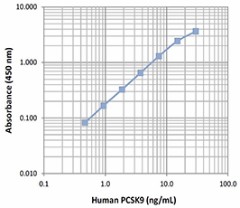- Regulatory Status
- RUO
- Other Names
- PCSK9, PC9, NARC1
- Ave. Rating
- Submit a Review
- Product Citations
- publications

| Cat # | Size | Price | Quantity Check Availability | Save | ||
|---|---|---|---|---|---|---|
| 443107 | 1 Pre-coated Plate | $497 | ||||
Proprotein convertase subtilisin/kexin 9 (PCSK9) belongs to the proteinase K subfamily of subtilases and is expressed as a soluble zymogen that undergoes autocatalytic intramolecular processing in the endoplasmic reticulum. It is a 692 amino acid (aa) glycoprotein with an overall domain structure similar to other proprotein convertase members. It is comprised of a signal peptide (aa 1–30), a pro segment (aa 31–152), a catalytic domain (aa 153–407), a hinge region (aa 408–452), and a C-terminal Cys-His-rich domain (aa 453–692).
The biological roles of PCSK9 are closely related to its binding partners, low-density lipoprotein (LDL) and LDL receptor (LDLR). At the cell surface, secreted PCSK9 binds at a neutral pH to the EGF-A-like repeat of the LDLR via its catalytic domain. The binding of PCSK9 to LDLR enhances the degradation of the LDLR in endosomes/lysosomes, which results in increased circulating LDL-cholesterol (LDL-C). Thus, PCSK9 has gained attention as a pharmacological target for cardiovascular diseases and atherosclerosis. It also binds to the Apoliprotein B (ApoB) in LDL, although its role in this complex is not clearly understood. Due to the interaction of PCSK9 with LDLR, the levels of free PCSK9 or its complexed forms are important indicators for measuring risk of cardiovascular diseases or response to a therapy.
The LEGEND MAX™ Human PCSK9 ELISA kit is a Sandwich Enzyme-Linked Immunosorbent Assay (ELISA) with a 96-well strip plate that is pre-coated with a rat monoclonal anti human PCSK9 antibody. This kit is specifically designed for the accurate quantification of human PCSK9, both free and complexed form with LDLR or LDL, in cell culture supernatant, serum, plasma, and other biological fluids. This kit is analytically validated with ready-to-use-reagents.
Kit Contents
- Kit Contents
-
- Anti-Human PCSK9 Pre-coated 96 well Strip Microplate
- Human PCSK9 Detection Antibody
- Human PCSK9 Standard
- Avidin-HRP
- Assay Buffer A
- Assay Diluent D
- Wash Buffer (20X)
- Substrate Solution F
- Stop Solution
- Plate Sealers
Product Details
- Verified Reactivity
- Human
- Application
-
ELISA
- Product Citations
-
- Sensitivity
- 0.125 ng/mL
- Standard Range
- 0.47 ng/mL - 30 ng/mL
- Materials Not Included
-
- Microplate reader able to measure absorbance at 450 nm
- Adjustable pipettes to measure volumes ranging from 1 µL to 1,000 µL
- Deionized water
- Wash bottle or automated microplate washer
- Log-Log graph paper or software for data analysis
- Tubes to prepare standard dilutions
- Timer
- Plate Shaker
- Polypropylene vials
Antigen Details
- Biology Area
- Cell Biology, Neuroinflammation, Neuroscience, Signal Transduction
- Molecular Family
- Enzymes and Regulators
- Gene ID
- 255738 View all products for this Gene ID
- UniProt
- View information about PCSK9 on UniProt.org
Related Pages & Pathways
Pages
Related FAQs
- In your LEGEND MAX™ ELISA Kits, there is a step that calls for washing the plates before adding sample. What is the purpose of this step?
-
We typically use a stabilizer for pre-coated plates. The additional washing step is designed to remove these components before you start the assay. If you do not perform the washing, the effect on assay performance is negligible.
- I have multiple LEGEND MAX™ ELISA kits that I want to run simultaneously. Can I use the same wash buffer for all the kits?
-
The wash buffer provided in all our LEGEND MAX™ kits is the same and the part numbers on the wash buffer bottles in these kits should be identical. For ELISA MAX™ Deluxe and ELISA MAX™ Standard Sets, we provide a recipe for the wash buffer on each kit’s technical data sheet. This recipe is the same for all ELISA MAX™ sets.
- For some of your ELISA kits, why do my serum samples require dilution with assay buffer?
-
In some cases, dilution with assay buffer is required to minimize the matrix difference between the samples and the standards to achieve better accuracy.
 Login/Register
Login/Register 













Follow Us